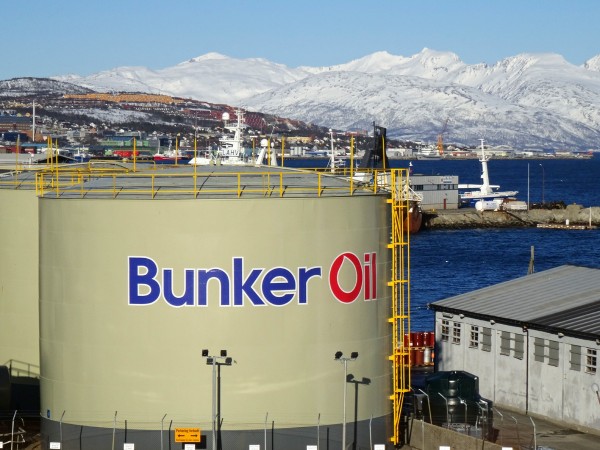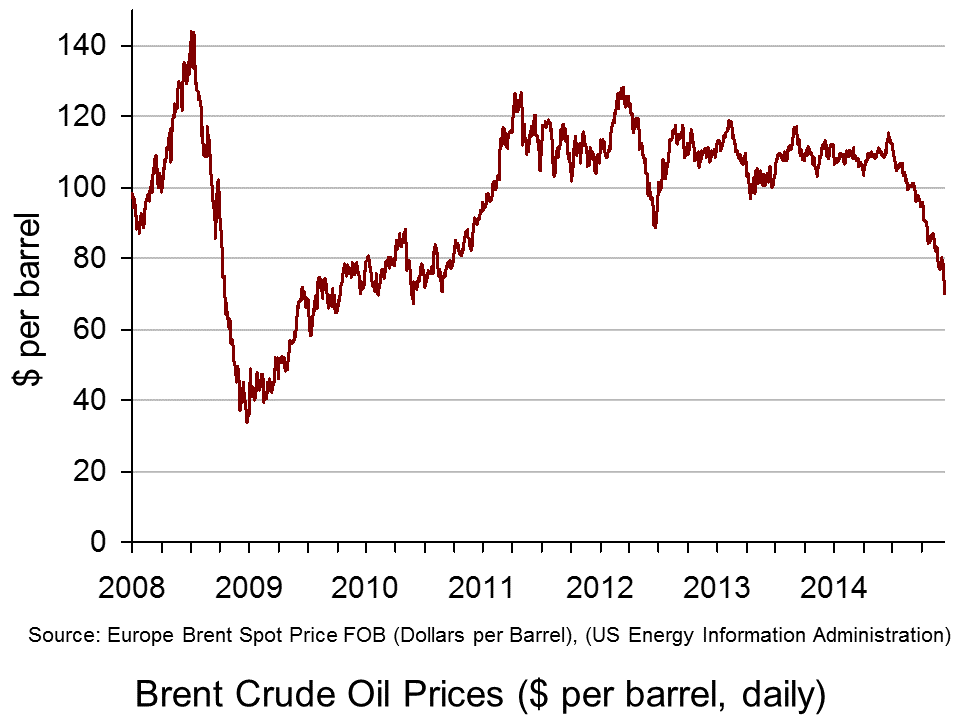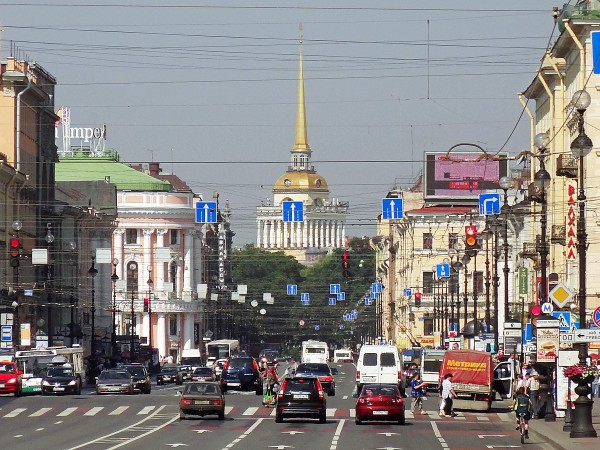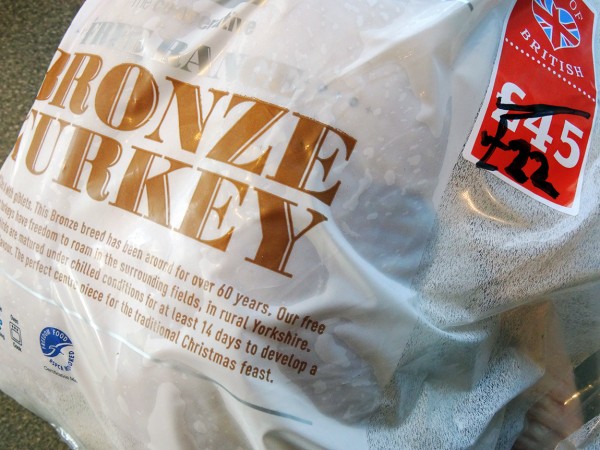 The demand for oil is growing and yet the price of oil, at around $46 per barrel over the past few weeks, remains at less than half that of the period from 2011 to mid 2014. The reason is that supply has been much larger than demand. The result has been a large production surplus and a growth in oil stocks. Supply did fall somewhat in October, which reduced the surplus in 2015 Q3 below than of the record level in Q2 – but the surplus was still the second highest on record.
The demand for oil is growing and yet the price of oil, at around $46 per barrel over the past few weeks, remains at less than half that of the period from 2011 to mid 2014. The reason is that supply has been much larger than demand. The result has been a large production surplus and a growth in oil stocks. Supply did fall somewhat in October, which reduced the surplus in 2015 Q3 below than of the record level in Q2 – but the surplus was still the second highest on record.
What is more, the modest growth in demand is forecast to slow in 2016. Supply, however, is expected to decrease through the first three quarters of 2016, before rising again at the end of 2016. The result will be a modest rise in price into 2016, to around $56 per barrel, compared with an average of just over $54 per barrel so far for 2015 (click here for a PowerPoint of the chart below).
 But why does supply remain so high, given such low prices? As we saw in the post The oil industry and low oil prices, it is partly the result of increases in supply from large-scale investment in new sources of oil over the past few years, such as the fracking of shale deposits, and partly the increased output by OPEC designed to keep prices low and make new investment in shale oil unprofitable.
But why does supply remain so high, given such low prices? As we saw in the post The oil industry and low oil prices, it is partly the result of increases in supply from large-scale investment in new sources of oil over the past few years, such as the fracking of shale deposits, and partly the increased output by OPEC designed to keep prices low and make new investment in shale oil unprofitable.
So why then doesn’t supply drop off rapidly? As we saw in the post, A crude indicator of the economy (Part 2), even though shale oil producers in the USA need a price of around $70 or more to make investment in new sources profitable, the marginal cost of extracting oil from existing sources is only around $10 to £20 per barrel.  This means that shale oil production will continue until the end of the life of the wells. Given that wells typically have a life of at least three years, it could take some time for the low prices to have a significant effect on supply. According to the US Energy Information Administration’s forecasts, US crude oil production will drop next year by only just over 5%, from an average of 9.3 million barrels per day in 2015 to 8.8 million barrels per day in 2016.
This means that shale oil production will continue until the end of the life of the wells. Given that wells typically have a life of at least three years, it could take some time for the low prices to have a significant effect on supply. According to the US Energy Information Administration’s forecasts, US crude oil production will drop next year by only just over 5%, from an average of 9.3 million barrels per day in 2015 to 8.8 million barrels per day in 2016.
In the meantime, we can expect low oil prices to continue for some time. Whilst this is bad news for oil exporters, it is good news for oil importing countries, as the lower costs will help aid recovery.
Webcasts
 IEA says oil glut could worsen through 2016 Euronews (13/11/15)
IEA says oil glut could worsen through 2016 Euronews (13/11/15)
 IEA Says Record 3 Billion-Barrel Oil Stocks May Deepen Rout BloombergBusiness, Grant Smith (13/11/15)
IEA Says Record 3 Billion-Barrel Oil Stocks May Deepen Rout BloombergBusiness, Grant Smith (13/11/15)
Articles
IEA Offers No Hope For An Oil-Price Recovery Forbes, Art Berman (13/11/15)
Oil glut to swamp demand until 2020 Financial Times, Anjli Raval (10/11/15)
Record oil glut stands at 3bn barrels BBC News (13/11/15)
Global oil glut highest in a decade as inventories soar The Telegraph, Mehreen Khan (12/11/15)
The Oil Glut Was Created In Q1 2015; Q3 OECD Inventory Movements Are Actually Quite Normal Seeking Alpha (13/11/15)
Record oil glut stands at 3 billion barrels Arab News (14/11/15)
OPEC Update 2015: No End To Oil Glut, Low Prices, As Members Prepare For Tense Meeting International Business Times, Jess McHugh (12/11/15)
Surviving The Oil Glut Investing.com, Phil Flynn (11/11/15)
Reports and data
Oil Market Report International Energy Agency (IEA) (13/11/15)
Short-term Energy Outlook US Energy Information Administration (EIA) (10/11/15)
Brent Crude Prices US Energy Information Administration (EIA)
Questions
- Using demand and supply diagrams, demonstrate (a) what has been happening to oil prices in 2015 and (b) what is likely to happen to them in 2016.
- How are the price elasticities of demand and supply relevant in explaining the magnitude of oil price movements?
- What are oil prices likely to be in five years’ time?
- Using aggregate demand and supply analysis, demonstrate the effect of lower oil prices on a national economy.
- Why might the downward effect on inflation from lower oil prices act as a stimulus to the economy? Is this consistent with deflation being seen as requiring a stimulus from central banks, such as lower interest rates or quantitative easing?
- Do you agree with the statement that “Saudi Arabia is acting directly against the interests of half the cartel and is running OPEC over a cliff”?
- If the oil price is around $70 per barrel in a couple of years’ time, would it be worth oil companies investing in shale oil wells at that point? Explain why or why not.
- Distinguish between short-run and long-run shut down points. Why is the short-run shut down price likely to be lower than the long-run one?
 Over the past three months oil prices have been falling. From the beginning of September to the end of November Brent Crude has fallen by 30.8%: from $101.2 to a four-year low of $70.0 per barrel (see chart below: click here for a PowerPoint). The fall in price has been the result of changes in demand and supply.
Over the past three months oil prices have been falling. From the beginning of September to the end of November Brent Crude has fallen by 30.8%: from $101.2 to a four-year low of $70.0 per barrel (see chart below: click here for a PowerPoint). The fall in price has been the result of changes in demand and supply.
As the eurozone, Japan, South America and other parts of the world have struggled to recover, so the demand for oil has been depressed. But supply has continued to expand as the USA and Canada have increased shale oil production through fracking.  As far as OPEC is concerned, rather than cutting production, it decided at a meeting on 27 November to maintain the current target of 30 million barrels a day.
As far as OPEC is concerned, rather than cutting production, it decided at a meeting on 27 November to maintain the current target of 30 million barrels a day.
The videos and articles linked below look at these demand and supply factors and what is likely to happen to oil prices over the coming months.
They also look at the winners and losers. Although falling prices are likely in general to benefit oil importing countries and harm oil exporting ones, it is not as simple as that. The lower prices could help boost recovery and that could help to halt the oil price fall and be of benefit to the oil exporting countries. But if prices stay low for long enough, this could lower inflation and even cause deflation (in the sense of falling prices) in many countries. This, in turn, could dampen demand (see the blog post, Deflation danger). This is a particular problem in Japan and the eurozone. Major oil importing developing countries, such as China and India, however, should see a boost to growth from the lower oil prices.
Major oil importing developing countries, such as China and India, however, should see a boost to growth from the lower oil prices.
Some oil exporting countries will be harder hit than others. Russia, in particular, has been badly affected, especially as it is also suffering from the economic sanctions imposed by Western governments in response to the situation in Ukraine. The rouble has fallen by some 32% this year against the US dollar and nearly 23% in the past three months alone.
Then there are the environmental effects. Cheaper oil puts less pressure on companies and governments to invest in renewable sources of energy. And then there are the direct effects on the environment of fracking itself – something increasingly being debated in the UK as well as in the USA and Canada.
Videos
 Oil price at four-year low as Opec meets BBC News, Mark Lobel (27/11/14)
Oil price at four-year low as Opec meets BBC News, Mark Lobel (27/11/14)
 Opec losing control of oil prices due to US fracking BBC News, Nigel Cassidy (4/12/13)
Opec losing control of oil prices due to US fracking BBC News, Nigel Cassidy (4/12/13)
 How the price of oil is set – video explainer The Telegraph, Oliver Duggan (28/11/14)
How the price of oil is set – video explainer The Telegraph, Oliver Duggan (28/11/14)
 How Oil’s Price Plunge Impacts Wall Street Bloomberg TV, Richard Mallinson (28/11/14)
How Oil’s Price Plunge Impacts Wall Street Bloomberg TV, Richard Mallinson (28/11/14)
 Oil Prices Plummet: The Impact on Russia’s Economy Bloomberg TV, Martin Lindstrom (28/11/14)
Oil Prices Plummet: The Impact on Russia’s Economy Bloomberg TV, Martin Lindstrom (28/11/14)
Articles
Oil prices plunge after Opec meeting BBC News (28/11/14)
Crude oil prices extend losses Financial Times, Dave Shellock (28/11/14)
Oil price plunges after Opec split keeps output steady The Guardian, Terry Macalister and Graeme Wearden (27/11/14)
Falling oil prices: Who are the winners and losers? BBC News, Tim Bowler (17/10/14)Hooray for cheap oil BBC News, Robert Peston (1/12/14)
Russian Recession Risk at Record as Oil Price Saps Economy Bloomberg, Andre Tartar and Anna Andrianova (28/11/14)
Rouble falls as oil price hits five-year low BBC News (1/12/14)
Data
Brent Spot Price US Energy Information Administration (select daily, weekly, monthly or annual: can be downloaded to Excel)
Spot exchange rate of Russian rouble against the dollar Bank of England
Questions
- Use a diagram to illustrate the effects of changes in the demand and supply of oil on oil prices.
- How does the price elasticity of demand and supply of oil affect the magnitude of these price changes?
- Explain whether (a) the demand for and (b) the supply of oil are likely to be relatively elastic or relatively inelastic? How are these elasticities likely to change over time?
- Distinguish between the spot price and forward prices of oil? If the three-month forward price is below the spot price, what are the implications of this?
- Analyse who gains and who loses from the recent price falls.
- What are the effects of a falling rouble on the Russian economy?
- What are likely to be the effects of further falls in oil prices on the eurozone economy?
 An annual event takes place every October that leads to a large number of frustrated consumers – the sale of tickets for the Glastonbury festival. This year the sale of standard tickets began at 9.00am on Sunday 5th October. Within 27 minutes all of the 120,000 tickets had been sold and it was reported that over a million people had tried to access the website. Social media was full of messages from disappointed fans that had been unable to get a ticket.
An annual event takes place every October that leads to a large number of frustrated consumers – the sale of tickets for the Glastonbury festival. This year the sale of standard tickets began at 9.00am on Sunday 5th October. Within 27 minutes all of the 120,000 tickets had been sold and it was reported that over a million people had tried to access the website. Social media was full of messages from disappointed fans that had been unable to get a ticket.
The Glastonbury festival has grown in popularity and the organisers adopted a unique way of selling the tickets a number of years ago. They introduced a system that made it impossible for people to purchase tickets unless they had previously registered. Although there is no charge to register, in order to complete the process successfully, people have to submit a clear passport style photograph in Jpeg format. Once registered, customers are allocated a unique registration number which they must submit in order to purchase a ticket when they go on sale. Each buyer can purchase up to a maximum of 6 tickets and must provide a valid registration number for each separate ticket they obtain. Successful applicants receive a personalised ticket, including their photo, which cannot be re-sold. The organisers have been very clear about the rationale for introducing this scheme. They have stated that it is part of their
“on-going efforts to cut out ticket touting”
However a number of people have criticised the ticket sale process. These criticisms tend to fall into two key areas: first, the method used in the initial sale process and second, the constraints placed on resale after a ticket has been purchased.
The tickets are sold by the company SeeTickets and their Head of Business Development stated in an interview in 2013 that:
 There is something like 1,100,000 customers registered to go to Glastonbury, and they all want a ticket. It’s a shame but there is nothing you can do about it. The 900,000 people that don’t get to go often come up with the argument, why don’t you just have a ballot? Why don’t we just register and a computer generated ballot just picks the winners? I think they’ve (Glastonbury) always had a view that if you get a ticket to Glastonbury there’s an element of work that you have to do to achieve that and it does reward that commitment. I think there’s a sense that if you use a ballot then maybe you’d get some people who were not as committed.
There is something like 1,100,000 customers registered to go to Glastonbury, and they all want a ticket. It’s a shame but there is nothing you can do about it. The 900,000 people that don’t get to go often come up with the argument, why don’t you just have a ballot? Why don’t we just register and a computer generated ballot just picks the winners? I think they’ve (Glastonbury) always had a view that if you get a ticket to Glastonbury there’s an element of work that you have to do to achieve that and it does reward that commitment. I think there’s a sense that if you use a ballot then maybe you’d get some people who were not as committed.
However responding to these comments a customer commented that:
I’ve been lucky in the past and got tickets within minutes and like this year tried all morning and come away empty handed. Whether I have been successful has nothing to do with hard work but the vagaries of the internet and a bit of luck.
Another customer commented:
No ballot! It’s too random. People who really,really want to go should get the tickets, so the only fair way is regional ticket sales, where you could queue ( overnight if required) to get your ticket. This is the only fair way. Year after year genuine fans miss out. This way fans who are willing to make an effort get the chance, rather than a ballot or the random computer system which they have at present.
Others have criticised the limited ability consumers are given to resell their tickets. The full cost of a ticket for the 2015 festival is £220 plus a £5 booking fee. When the tickets are originally sold in October, the buyers have to pay a £50 deposit and at this point none of the bands playing at the festival have been announced. The remaining balance of £175 is due at the beginning of April by which point some of the bands/acts will have been confirmed. Anyone who decides not to pay the balance or cancel their order before this date is refunded their deposit, minus an administration fee. Those tickets are then put forward for re-sale. The re-sale process typically takes place at the end of April and once again is only open to people who have previously registered. Last year 10,000 tickets were re-sold in just 12 minutes! Once this period in April is over the re-sale of tickets is prohibited even though the complete line-up for the festival may not have been confirmed.
The secondary ticket company Viagogo reported the results from research they had carried out on the 2014 festival. This found that following the relatively late announcement of Metallica as one of the headline acts,78% of people who had bought a ticket said they would have resold it if they’d had the chance.
A spokesperson from Viagogo stated that:
We believe that once you’ve bought a ticket it’s yours and if you want to sell it or give it away, you should be allowed to do so. In this case, with an unpopular headline act announced late, ticket holders lose out because they can’t resell their tickets and Metallica fans lose out because they can’t buy them.
Those people who either did not get a ticket or are left with a ticket they would rather re-sell will no doubt continue to complain about the ticket selling process.
Articles
Questions
- What is the opportunity cost of going to the Glastonbury Festival? Discuss some of the non-ticket factors you have included in your calculations.
- Draw a demand and supply diagram to illustrate the market for Glastonbury tickets. NB think carefully about the shape of the supply curve in both the short-run and the long run. Is the current price of a ticket at the market clearing level? Explain your answer.
- The sale and re-sale of tickets takes place before the all the headline acts have been announced. Illustrate what will happen to the demand curve for consumers with different preferences once the headline acts have been announced.
- Assess the relative costs and benefits of using a ballot instead of the current system used by the festival organisers to sell of tickets.
- The organisers of the festival introduced the registration process in order to limit the re-sale of the tickets. Analyse the impact of this policy on Pareto and allocative efficiency? Will the policy cause any deadweight welfare loss? What factors will determine the size of any deadweight welfare loss?
- Suggest some reasons why care may need to be taken when using the results from the research carried out by Viagogo.
 A few months ago, in a post on this site I reported that the Competition Commission (CC) had completed their provisional investigation into the concrete and cement market in Great Britain. As I discussed, they concluded that coordination between the main cement producers was resulting in high prices. They are particularly concerned about the impact of high prices in this market because:
A few months ago, in a post on this site I reported that the Competition Commission (CC) had completed their provisional investigation into the concrete and cement market in Great Britain. As I discussed, they concluded that coordination between the main cement producers was resulting in high prices. They are particularly concerned about the impact of high prices in this market because:
Cement is an essential product for the construction and building sectors and the amount of such work that is funded by the public purse only underlines the importance of ensuring that customers get better value for money. We believe our measures can bring about a substantial, swift and lasting increase in competition in this economically vital market.
The next step was for the CC to consider how they could remedy the situation and hopefully improve competition in the market.
Earlier this month, the CC announced the remedies they intend to impose. Having previously suggested that they intended to impose hard-hitting measures, they have been true to their word. The market leader, Lafarge Tarmac, will be required to sell one of its cement plants to facilitate a new entrant into the market. According to Professor Martin Cave, the CC’s Deputy Chairman who led the inquiry:
We believe that the entry of a new, independent cement producer is the only way to disturb the established structure and behaviour in this market which has persisted for a number of years and led to higher prices for customers.
In addition, the CC is also putting in place measures to limit the publication of production data and price announcements. It is hoped that these measures will reduce transparency in the market.
However, Lafarge Tarmac disagrees with the sale they are being forced to make. This is in part because, as I discussed in the earlier post, they had previously been allowed by the CC to form a joint venture (JV) with one its main rivals:
We are disappointed that the Competition Commission has asked Lafarge Tarmac to divest another cement plant only a year after it allowed the creation of the JV. This is not reasonable or proportionate and we have not been given a fair opportunity to defend our position.
In addition, Lafarge Tarmac is quoted in the above article as suggesting that the end result of the CC’s intervention will be harm to consumers. It will be extremely interesting to monitor how this market develops.
Articles
Competition Commission confirms plan for new cement producer The Construction Index, (14/01/14)
Competition Commission improves competition in the UK. Again. Global Cement, (22/01/14)
Report
Aggregates, cement and ready-mix concrete market investigation, Final report, Competition Commission, (14/01/14)
Questions
- Why might the publication of production data and price announcements help to facilitate coordination between firms?
- Would you expect the new entrant or the measures to limit the publication of production data and price announcements to have more impact on competition in the market?
- Using a supply and demand model, describe the impact the CC’s intervention could have on the construction market.
 According to the supply and demand model, we would expect the price of turkeys to be high at this time of year. After all, last Christmas in the UK over 10 million turkeys were consumed and, therefore, this high level of demand should cause prices to rise. This is certainly what happens in other markets when there is a substantial increase in demand.
According to the supply and demand model, we would expect the price of turkeys to be high at this time of year. After all, last Christmas in the UK over 10 million turkeys were consumed and, therefore, this high level of demand should cause prices to rise. This is certainly what happens in other markets when there is a substantial increase in demand.
However, evidence from Thanksgiving in the USA suggests that this might not be the case. According to this article from the New York Times, data suggests that the price of frozen turkeys in the US falls by around 9% between October and November, coinciding with the substantial increase in demand for Thanksgiving celebrations. The article then goes on to suggest a number of plausible demand and supply-side explanations for this fall in price.
Turkey Economics 101: Why turkeys are so darn cheap this time of year Culinate (25/11/13)
Why Does Turkey Get Cheaper Around Thanksgiving? Slate, Matthew Yglesias (21/11/12)
Questions
- How elastic do you think the demand for turkeys will be at Christmas?
- What type of products are well suited to being used as loss-leaders?
- Which of the explanations for the increase in prices do you find most convincing?
- What evidence might be useful to distinguish between the different explanations?
 The demand for oil is growing and yet the price of oil, at around $46 per barrel over the past few weeks, remains at less than half that of the period from 2011 to mid 2014. The reason is that supply has been much larger than demand. The result has been a large production surplus and a growth in oil stocks. Supply did fall somewhat in October, which reduced the surplus in 2015 Q3 below than of the record level in Q2 – but the surplus was still the second highest on record.
The demand for oil is growing and yet the price of oil, at around $46 per barrel over the past few weeks, remains at less than half that of the period from 2011 to mid 2014. The reason is that supply has been much larger than demand. The result has been a large production surplus and a growth in oil stocks. Supply did fall somewhat in October, which reduced the surplus in 2015 Q3 below than of the record level in Q2 – but the surplus was still the second highest on record. But why does supply remain so high, given such low prices? As we saw in the post The oil industry and low oil prices, it is partly the result of increases in supply from large-scale investment in new sources of oil over the past few years, such as the fracking of shale deposits, and partly the increased output by OPEC designed to keep prices low and make new investment in shale oil unprofitable.
But why does supply remain so high, given such low prices? As we saw in the post The oil industry and low oil prices, it is partly the result of increases in supply from large-scale investment in new sources of oil over the past few years, such as the fracking of shale deposits, and partly the increased output by OPEC designed to keep prices low and make new investment in shale oil unprofitable. This means that shale oil production will continue until the end of the life of the wells. Given that wells typically have a life of at least three years, it could take some time for the low prices to have a significant effect on supply. According to the US Energy Information Administration’s forecasts, US crude oil production will drop next year by only just over 5%, from an average of 9.3 million barrels per day in 2015 to 8.8 million barrels per day in 2016.
This means that shale oil production will continue until the end of the life of the wells. Given that wells typically have a life of at least three years, it could take some time for the low prices to have a significant effect on supply. According to the US Energy Information Administration’s forecasts, US crude oil production will drop next year by only just over 5%, from an average of 9.3 million barrels per day in 2015 to 8.8 million barrels per day in 2016. IEA says oil glut could worsen through 2016 Euronews (13/11/15)
IEA says oil glut could worsen through 2016 Euronews (13/11/15) IEA Says Record 3 Billion-Barrel Oil Stocks May Deepen Rout BloombergBusiness, Grant Smith (13/11/15)
IEA Says Record 3 Billion-Barrel Oil Stocks May Deepen Rout BloombergBusiness, Grant Smith (13/11/15)




